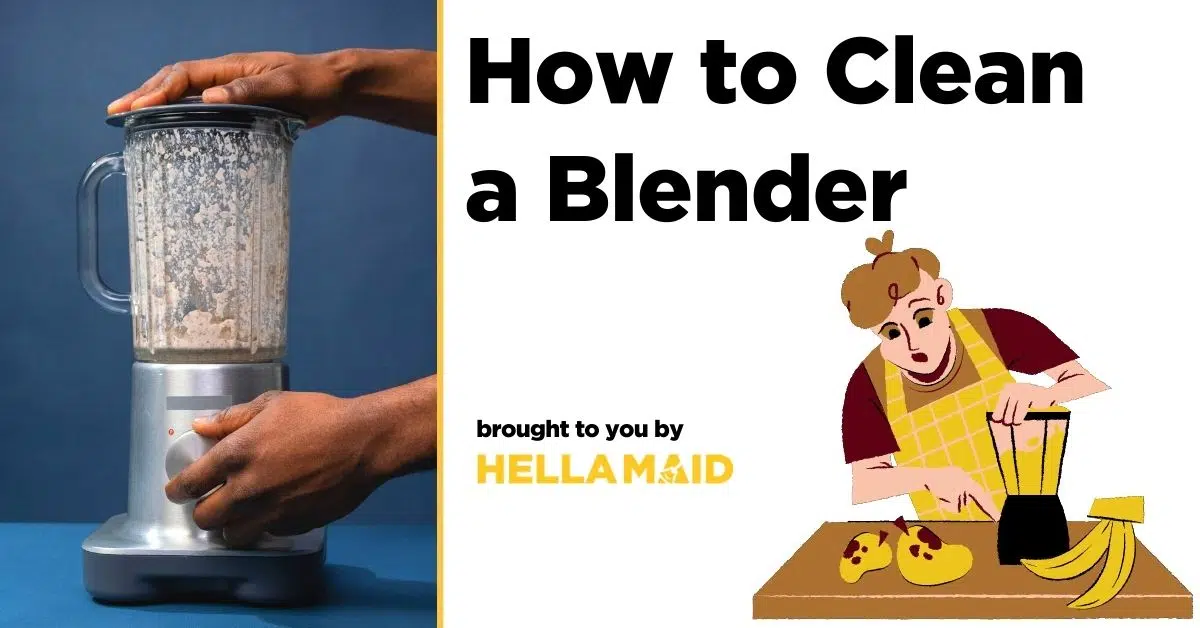Key Points
- Corian sinks are durable and non-porous, but daily use can still leave stains from food and drinks, hard water deposits, cooking oils, and rust from metal items.
- The best way to clean a stained Corian sink is to start with mild soap, then use baking soda paste for stubborn spots, vinegar for hard water stains, or a non-abrasive cleaner if needed.
- For stubborn stains or time-saving care, professional cleaners like Hellamaid can safely restore Corian surfaces while keeping your kitchen fresh.
Your Corian sink is one of the most beautiful features in your kitchen. It’s sleek, durable, and adds elegance to your space. But when stains start to appear, it can feel overwhelming to restore that pristine look you love. Don’t worry, cleaning a stained Corian sink is easier than you think!
This guide will walk you through everything you need to know, from understanding what Corian is to expert tips for long-term care.
What is a Corian Sink?
Corian is a brand name for a solid surface material created by DuPont. It is made from a blend of acrylic polymer and alumina trihydrate, a mineral derived from bauxite ore. This combination makes it a non-porous and durable material. Because it is non-porous, it resists stains and bacterial growth.
That is why it’s a popular choice for both residential and commercial kitchens. It offers a sleek, modern look that fits many design styles.
Common Causes of Stains in Corian Sinks
Stains on a Corian sink are usually not a sign of damage. They are simply marks left by daily use. Knowing the cause can help you choose the right cleaning method. Here are some of the most common culprits:
- Food and Drink: Coffee, tea, red wine, and food dyes are very common. They can leave noticeable marks if not wiped up quickly.
- Hard Water: In many parts of Canada, water has a high mineral content. These minerals can build up over time. This leaves a white or chalky residue on the surface.
- Cooking Oils: Oils and grease can leave a thin film on the surface. This film can attract dirt and cause a dingy appearance.
- Metal Rust: Metal pots, pans, or utensils left in the sink can cause rust marks. This is especially true if water pools around them.
Supplies You’ll Need to Clean a Corian Sink
Before you start, gather your cleaning supplies. You likely have most of these items already in your kitchen. This approach keeps cleaning simple and accessible for everyone.
- Mild dish soap
- Baking soda
- White vinegar
- Non-abrasive sponge or cloth
- Soft-bristle brush
- Spray bottle
- Non-abrasive household cleaner (optional)
Step-by-Step: Best Way to Clean a Stained Corian Sink
This method is safe and effective for almost any stain. Follow these steps to help you restore your Corian sink’s original beauty without damaging the surface:
Step 1: Start with Gentle Cleaning
The easiest way to deal with stains is to begin simple. Fill the sink with warm water and add a few drops of mild dish soap. Let it soak for 5–10 minutes, especially if stains are visible. Then, use a soft microfibre cloth to wipe the surface, focusing on areas near the drain and faucet, where buildup is most common.
Rinse well and dry with a towel. Surprisingly, this step removes about 70% of common stains, so if your sink looks spotless, you can stop here.
Step 2: Apply Baking Soda Paste for Stubborn Stains
When mild soap isn’t enough, baking soda is a safe next option. Create a thick paste (3 parts baking soda to 1 part water) and spread it over the stain. Let it sit for 10–15 minutes before scrubbing lightly with a soft toothbrush.
This is especially effective for coffee, tea, or food stains that cause discolouration. Remember, no need to scrub hard; let the baking soda do the work.
Step 3: Treat Hard Water Stains with Vinegar
Hard water stains are very common in Canadian homes. In fact, according to Canada Health reports that many Canadian municipalities experience hard water, in relates to Green Building’s claim that there are 50% of municipal water supplies in Canada have hardness levels below 80 mg/l.
The good news is that white vinegar is one of the safest and most effective ways to handle them:
- Mix a solution: Combine equal parts vinegar and water in a spray bottle.
- Spray generously: Apply it directly to the stained areas.
- Let it work: Allow it to sit for 5–10 minutes so the acid can break down the mineral deposits.
- Scrub gently: Use a non-abrasive sponge to loosen the buildup.
- Rinse well: Always wash away any vinegar residue to keep your Corian surface from dulling.
Pro Tip: For heavier buildup, you can soak a cloth in undiluted vinegar and lay it over the stains for 15–20 minutes before rinsing.
Step 4: Try a Non-Abrasive Cleaner (If Needed)
If home remedies don’t work, a non-abrasive cream cleaner designed for solid surfaces can help. Apply a small amount to the stained area, gently work it in with a cloth, and follow the product’s instructions closely.
Pro Tip: Always test commercial cleaners in a hidden spot first to make sure they won’t damage your finish.
Step 5: Rinse and Dry Completely
The final step is crucial: rinse your sink with cool water until all cleaning residue is gone. Leftover cleaner can actually attract dirt and cause new stains.
Dry the sink completely with a soft towel, paying attention to corners and edges where water collects. For an added touch, buff the surface with a dry microfibre cloth to restore its natural shine.
Expert Tips to Maintain a Corian Sink
Prevention is always easier than deep cleaning. Here’s a simple routine you can follow to keep your Corian sink looking new and spotless:
| Routine | What to Do |
|---|---|
| Daily Habits | – Rinse after each use – Wipe dry with a soft cloth – Avoid leaving spills overnight – Use a sink mat during heavy dish washing |
| Weekly Maintenance | – Clean with mild soap and water – Check for early signs of staining – Polish with a microfibre cloth – Clear soap buildup around the faucet |
| Monthly Deep Clean | – Refresh with a baking soda paste – Clean the overflow area – Inspect for scratches that may need professional care |
Additionally, proper maintenance can extend the life of solid surface materials like Corian by up to 20 years, making your sink a long-lasting investment.
Frequently Asked Questions
Here are additional common questions homeowners ask about cleaning Corian sinks:
FAQ #1: Can I use bleach on a Corian sink?
No, avoid bleach on Corian surfaces. Bleach can cause permanent discoloration and damage the material’s finish. It may also create a chalky residue that’s difficult to remove.
Instead, use the gentle methods outlined above. They’re safer and just as effective for removing stains and disinfecting your sink.
FAQ #2: Can I use a magic eraser on Corian?
No, magic erasers are too abrasive for Corian sinks. They can create micro-scratches that make the surface look dull and attract more dirt over time.
Stick to soft cloths and non-abrasive sponges. Your sink will maintain its smooth finish and natural shine much longer.
FAQ #3: What should I avoid when cleaning a Corian sink?
Avoid these common mistakes:
- Abrasive cleaners or scrubbers
- Extremely hot water (over 212°F)
- Letting stains sit for days
- Using the sink as a cutting board
Also avoid products containing acetone, as they can permanently damage the surface.
Conclusion
Keeping a Corian sink clean and stain-free is a simple task. Regular, gentle care is the most effective approach. By following these easy steps, you can maintain your sink’s beauty for years to come. Remember, the best way to clean a stained Corian sink is to be gentle and consistent.
Let Hellamaid Handle Stubborn Stains
Not everyone has the time to deal with tough stains and deep cleaning. That’s where Hellamaid’s professional cleaning services can help. Our trusted cleaners know how to handle delicate surfaces like Corian while keeping your whole kitchen fresh and hygienic.
Enjoy:
- Easy online booking with no hidden fees
- Customized cleaning service based on what your space needs
- Save more with our digital gift cards
Let Hellamaid handle the hard work so you can enjoy a cleaner, healthier home!































